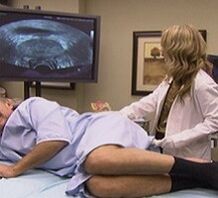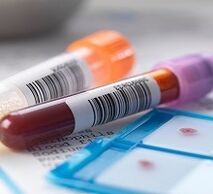How to determine prostatitis?This question is often asked for a doctor.According to doctors, it is possible to identify the inflammation process in the prostate gland only with a comprehensive examination.
To make a diagnosis, oral surveys and physical examination are performed.Further, the doctor prescribes instrumental and laboratory tests to the patient.Based on the data obtained, the final diagnosis is made and treatment tactics are selected.
Prostatitis can be eliminated medication or surgery.Priority is drug therapy.Surgical intervention is only prescribed if abscess, suppuration or other complications of the disease develops.
What symptoms exist in prostatitis?
Prostatitis is a disease in which the prostate iron is inflamed.In this case, the body can increase size and swell.As a result of the development of the inflammatory process, dysuric disorders appear, sperm quality decreases, and sexual disorders develop.
How to identify prostatitis in men and distinguish it from other pathologies?Everything is quite simple, as the disease has its characteristics.But, unfortunately, the disease can flow asymptomatically for a long time, so it is often diagnosed at a later stage.
Thus, the following signs exist in prostatitis:
- Zuric disorder.The disease can be manifested with frequent urination, urination and even urinary retention.At night, the patient is tortured by false urine.After clearing the bladder, incomplete emptying feelings may occur.
- Sore.With prostatitis, the throat hurts.The severity of the symptoms during urination and during sexual intercourse is increasing.Pain can be transmitted into the penis, lower back and penis.
- Constipation.They are observed in chronic forms of stagnant prostatitis.
- Violations of sexual function.In patients, potential and decreased libido, premature ejaculation occurs.It happens that a man, on the other hand, is difficult to solve during sex.The severity of orgasm with prostatitis is reduced.
- The appearance of blood or mucus in the urine.At the same time, severe itching in the urethra can occur during urination.These symptoms are observed in the form of bacterial disease.
- Reduces quantitative and qualitative indicators of sperm.
- Nausea, chills, fever, general weakness, smear in the body.These features are characteristic of acute bacterial prostatitis.
IMPORTANT!When the above marks appear, you should contact the urologist immediately.
How is the diagnostics run?
Physical examination and oral review

Let us consider in more detail how to identify prostatitis in men.First, the patient should consult a urologist.Doctors should study the history of the patient and reveal whether the man had chronic illness of the genitourinary system.
Initially, prostate physical examination was performed.The doctor inserted a finger into the patient's anus and examined the iron into the touch.To distinguish healthy prostate from patients is very easy.If the organ is inflamed, then on the palpation, the note is that the pancreas is swollen and has a heterogeneous structure.Basically, it is already at this stage to diagnose prostatitis.
To get the right clinical picture, a oral survey is conducted.The urologist explains:
- What lifestyle leads the patient.
- How long the symptoms of prostatitis have appeared.
- Are there any infectious/viral diseases before.
- What is the concern for patient labor activity.
- Whether the patient transfers the operation where the intervention is performed to the pelvic organs.
IMPORTANT!In addition, doctors may conduct physical examination of the scrotum.Doctors draw attention to the size of the scrotum, shape and consistency, as well as the movement of the penis.
Instrumental diagnostics

To identify prostatitis, instrumental diagnosis is required.The main diagnostic event is the ultrasound (ultrasound) examination of the prostate gland.
Ultrasound is carried out in several ways.These organs can be inspected through the front abdominal wall, or use a specific transrectal sensor.When using a sensor, you can get a more accurate clinical picture.
In addition to ultrasound, they can be appointed:
- Urofloometry.
- The MRI prostate gland.
- Ct prostate.
IMPORTANT!If suspected of benign/malignant tumors, glandular organ biopsy may be recommended to the patient.
Laboratory research

With prostate inflammation, several tests must be taken.Laboratory diagnostics will understand what actually provokes pathogenic processes in the gland organs, and whether prostatitis has bacterial/contagious properties in this case.
First of all, the patient is prescribed a blood test on PSA - a prostatic specialty antigen.Analysis is needed to find out if there is a tendency for DHCS/cancer.Usually, the dog's level should try to zero.
In addition to blood tests on PSA, it is recommended:
- Sperm.
- General blood test.
- Cytological, general and bacterial urine analysis.
- Take a smear from the urethra.
- Pancreatic secretion study.
- Research by PCR.
IMPORTANT!Based on the data obtained, the doctor can make the final diagnosis and, thus, select the treatment tactic.
How to treat prostatitis?

By detecting prostate inflammation, everything is very clear.Let us consider the method of treating prostatitis.Therefore, as mentioned above, there are two ways to solve this problem - to undergo conservative or surgical treatment.
Surgical intervention is prescribed if prostatitis is accompanied by complications such as DGPZ, abscesses, urinary retention, anuria, stone appearance in the gland organs.Three main methods are used - prostatectomy, prostate resection and laser therapy.
Conservative treatment is preferred and used in most cases.It provides:
- Make a healthy lifestyle.Patients should understand that bad habits will slow down the recovery process.We need to reject cigarettes and alcohol once and for all.
- A balanced diet.In urological diseases, you must definitely adhere to your diet.It is recommended to get rid of fatty dishes, half -finished products, fast food, fried foods from diet.It also prohibits carbonated drinks, as they cause intestinal irritation, which is useless for prostatitis.
- Visit the physiotherapy procedure.You can eliminate inflammation through acupuncture, moxotherapy, electrophoresis, UVT, Thai massage.Prostate massage is also very useful.
- Avoid hypothermia, as it is the main cause of stagnant prostatitis.
- Take certain medications for prostatitis.Antibiotics, bioregulatory peptides, alpha-1-adrenal vessels, NSAIDs, antispasmodic and phytopreparations are prescribed.
- Lead a full sex life (if possible).If a man refrains from sex, then he can once again obtain prostatitis after therapy.Sexual activities with pancreatic inflammation will be useful.The main thing is to use barrier contraception.
In addition, patients can use folk treatment methods.But keep in mind that they are nothing more than extra.With pancreatic inflammation, boil aspen, honey down, microclism with useful chamomile.

























